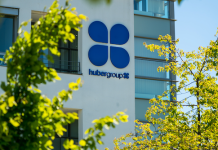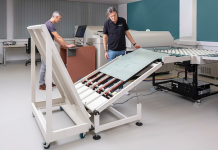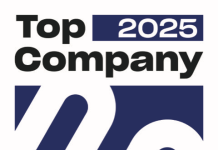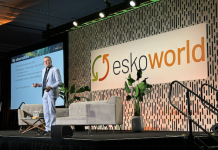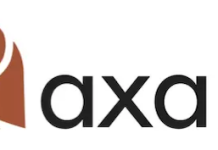Shoei Printing Co. have introduced a 8-colour Lithrone G37P A1-size convertible perfecting press for consolidating small-lot mail-order printing jobs.
Shoei Printing Co. is a global company with offices in Vietnam and China in addition to its headquarters in Niigata and offices in Tokyo and Osaka. Originally focused on publication printing, the company has entered the mail-order printing field and is rapidly expanding its business.
President and Representative Director Masayuki Sakai, Managing Director Masashi Watanabe, Deputy Factory Manager Yuki Narita, and Production Department 1 Manager Yuji Kobayashi were asked about realising high profitability in the mail-order printing business and shop floor-led improvements after the Lithrone perfector installation.
In response to changes in the printing industry environment, Shoei Printing President & Representative Director Sakai said, ‘The printing industry is shrinking every year due to digitalisation and paperless issues. Amid this, we have a mail-order printing division that we must strengthen.’
The company already owns an 8-colour, 101.6cm (40 inch) perfector which can handle a variety of printing needs, such as double-sided one-pass printing and multicolour single-sided printing. For their most recent investment, the company introduced an 8-colour Lithrone G37P 93.9cm (37 inch) perfector to strengthen its mail-order printing business. Sakai said, ‘We chose this machine because we needed equipment that could provide high printing quality even though we specialise in mail-order printing.’
One of the key points in selecting the machine was its profitability in small-lot mail-order printing work. Sakai said, ‘The Lithrone G37P offers high production efficiency for small-lot jobs due to the fast job changeover realised by simultaneous automatic plate changing and cleaning. In addition, the 37 inch size, which is just right for A1-size jobs such as catalogues and booklets, has a smaller plate size than the 40 inch size press, resulting in a 20 percent cost reduction. The cost savings are very significant because we use 4000 to 5000 plates per month.’
Besides the printing presses, the company is also working to automate and improve the efficiency of its postpress equipment and has already introduced the Apressia CTX132 programmable hydraulic clamp cutting system. Sakai said, ‘Both the Lithrone G37P and the Apressia CTX132 are limited to A1-size work, and by patterning the process, automation has improved, resulting in maximum production efficiency.’ Deputy Factory Manager Narita said, ‘The Lithrone G37P presets air settings for each paper type, while the Apressia CTX132 calls up the cutting order and position information for each imposition pattern and presets these automatically. This automation prevents human error and dramatically increases productivity.’
Sakai, who emphasised the importance of making the factory a place where young people are motivated to work, said, ‘We selected this machine in response to feedback from the shop floor that this printing machine, which specialises in automation and labour-saving, would enable us to train a young employee to become a printing chief within one year.’
Since its introduction, work is efficiently shared, with the Lithrone G37P, which is staffed by young operators, handling small-lot, mail-order printing jobs while the 40 inch perfector prints other work, steadily generating profits.
The press features Parallel Makeready, which reduces changeover time by performing automatic blanket washing, plate changing, and pre-inking at the same time. Narita said, ‘Parallel Makeready is important for us because we are always concerned about cutting times, by even one minute. The time between the end of the previous job and the start of the next job has been reduced by about 60 percent compared to previous presses without parallel makeready style controls. As a result, the number of jobs per hour has increased, and production efficiency has greatly improved.’
Kobayashi explained, ‘Pre-inking is set for each paper type, such as coated, matte, and wood-free paper. Furthermore, the control system is updated and optimised daily by the self-learning function, so colours close to the standards are produced on the first test printing. We are able to start production printing after one or two test printings of around 70 sheets.’
In addition, the delivery performance that enables high-speed printing with stable quality in oil-based double-sided printing supports productivity. Narita said, ‘Printing speed is also important to ensure the productivity we aim for. Komori’s unique delivery for oil-based double-sided printing, which combines the transfer cylinder transport with belt transport at the same speed as the printing speed, eliminates paper fluttering and smearing even at high speeds of 15,000 sph.’ These effects have actually resulted in the completion of 111 jobs in 24 hours of operation. Sakai said, ‘It depends on the lot size, but we are aiming for 6 to 8 jobs per hour.’
Kobayashi said, ‘KP-Connect not only provides operating information on the entire press, but also the work performance of each operator, so we can immediately see each issue in numbers. This is why we conduct improvement activities not on a monthly basis but on a daily basis. By sharing information on improvements with everyone and repeating the PDCA cycle, I feel that our operators are able to grow and feel a sense of fulfilment in their work.’
KOMORI
https://www.komori.eu/






